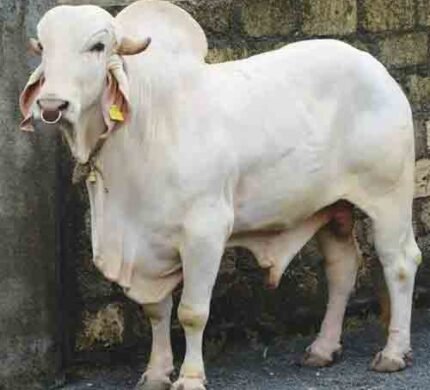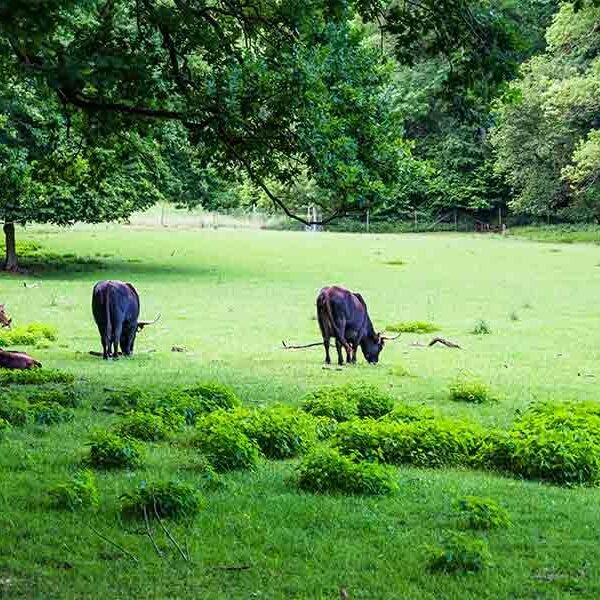Gir Cow
- Temperature:45 degrees Celsius
- Milk:5-6 liters of milk per day
- Food:Grazers, green grass and hay
- Pregnancy:Around 9 months
- Nationality:Gir forest region of Gujarat, India

General Information
The Gir cow, also known as the Gir breed or Gir cattle, is a type of cattle that originated in the Gir forest region of India. It is a hardy breed that is well adapted to the hot and humid climate of the region. The breed is known for its large size, with mature cows weighing between 400 and 600 kg and bulls weighing up to 900 kg.
Gir cows have a distinctive appearance, with a hump on their shoulders and long, pendulous ears. Their coat is usually a reddish-brown color, although some individuals may have white markings on their faces and legs. They are known for their gentle temperament and are often used for dairy and beef production.
In India, Gir cows are highly valued for their milk, which is rich in nutrients and has a high fat content. The breed is also known for its resistance to many common cattle diseases, making it a popular choice for farmers who want to reduce their use of antibiotics and other veterinary treatments.
In recent years, there has been growing interest in Gir cows outside of India, with breeders in other countries starting to import them for their milk and beef production. However, because the breed is native to India, there are strict regulations around exporting live animals or their genetic material, which can make it difficult to acquire purebred Gir cows outside of the country.
Where we find this cow to buy?
Gir cows are primarily found in India, as they are native to the Gir forest region in the state of Gujarat. They are widely available for purchase from livestock breeders and farmers in India.
If you are interested in purchasing Gir cows, you can start by researching local livestock markets or breeders in your area. You can also contact your nearest agricultural university or veterinary college for information on reputable breeders or farms that specialize in Gir cows.
Additionally, you may find Gir cows for sale through online marketplaces or classified ads, but it’s important to exercise caution when purchasing cows online and make sure to verify the seller’s reputation and the animal’s health status before making a purchase.
It’s worth noting that purchasing and transporting live animals can be complex and involve various regulations and restrictions. It’s important to do your research and ensure that you have the necessary permits and clearances before buying a Gir cow or any other livestock animal.

How to increase milk production in Gir Cow?
01
Gir cows require a balanced diet that is rich in protein, energy, and essential nutrients like calcium, phosphorus, and vitamins.
02
Gir cows need adequate rest to maintain good health and produce milk. They should be given a clean and comfortable place to rest, and not be subjected to any stress or strenuous activities.
03
A clean environment is essential for good health and milk production. Ensure that the cow’s living area is clean and free of any dirt, debris, or harmful bacteria.
04
Moderate exercise can be beneficial for the cow’s health and milk production. However, excessive exercise can cause stress and reduce milk production.
05
Regular vaccinations and medical care are important to ensure the cow’s health and prevent any diseases that may reduce milk production.
06
In some cases, hormonal treatments may be recommended to increase milk production.
Medicine
As with all livestock animals, Gir cows may require medical attention from time to time. If your Gir cow is sick or injured, it’s important to consult a veterinarian to determine the appropriate treatment. Here are some common medicines that may be used to treat various health issues in Gir cows:
01
AntibioticsAntibiotics may be prescribed to treat bacterial infections like mastitis, pneumonia, or foot rot.
02
Anti-inflammatory DrugsAnti-inflammatory drugs may be used to reduce pain and swelling associated with conditions like arthritis or mastitis.
03
AnthelminticsAnthelmintics are medications used to treat parasitic infections, including roundworms and other internal parasites.
04
HormonesHormonal therapies may be used to stimulate estrus in cows, promote milk production, or synchronize breeding cycles.

- Green fodder: Gir cows can be fed a variety of green fodder like alfalfa, maize, sorghum, and grass. Green fodder is rich in nutrients and fiber, and it provides essential vitamins and minerals to the cow's diet.
- Dry Fodder: Dry fodder like hay, straw, and silage can also be fed to Gir cows to supplement their diet during the dry season. These foods are rich in fiber and provide energy to the cow.
- Concentrate feed: Concentrate feed, such as grains, legumes, and oil cakes, are high in protein and energy and can be added to the cow's diet to increase milk production.
- Minerals and vitamins: Gir cows require minerals and vitamins to maintain good health and optimal milk production.
Important!
It’s important to note that the diet of Gir cows should be balanced and meet their nutritional requirements. Feeding them too much or too little of any food can lead to digestive problems, weight loss, or other health issues.nutritionist to develop a diet plan that meets the specific needs of your herd.
Pregnancy
The gestation period for Gir cows is approximately 9 months, and during this time, they require special care to ensure a healthy pregnancy and a successful delivery. Here are some important things to keep in mind when your Gir cow is pregnant:
It is important to consult a veterinarian to ensure that the cow is healthy and receives any necessary treatments or medications. Regular check-ups and vaccinations are also important.
During pregnancy, Gir cows require adequate rest and limited exercise to avoid injury or stress. They should be provided with a clean and comfortable place to rest, and should not be subjected to any strenuous activities.
After calving, the cow will require extra care and attention to ensure she recovers well. She should be fed a nutritious diet to support milk production, and regular check-ups are important to ensure the health of the cow and the calf.
Facts
Here are some interesting facts about Gir cows:
A Gir cow is highly adaptable to any climate, including hot and humid.
Milk production of Gir cows can range from 1500-2000 liters per lactation.
A Gir cow is highly adaptable to any climate, including hot and humid.
Gir cows are typically reddish-brown in color, with white markings on their face and legs.
Gir cows are known for their strength and are often used as draught animals in India.
Genetic resources of Gir cows have been studied extensively, and they are considered valuable.
Gir cows have a relatively long lifespan, with some cows living up to 15 years or more.
The Gir cow produces both milk and meat, making it a dual-purpose breed.